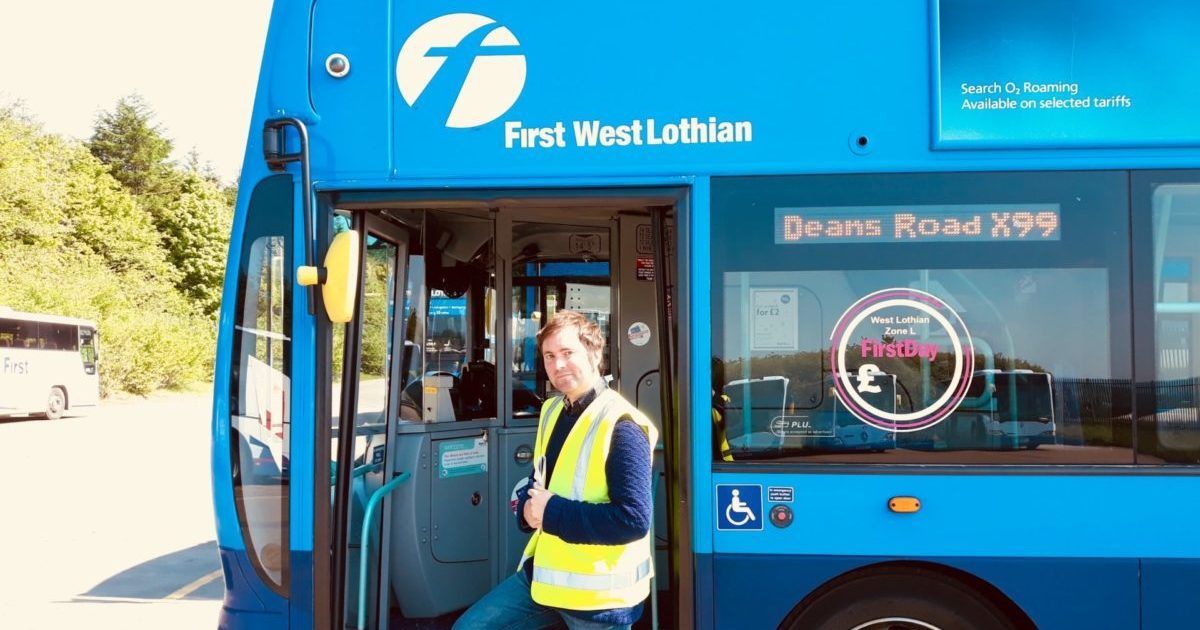Writer and historian Daniel Gray leads the final stage of our ReimagiNation tour of Scotland’s New Towns. He’s been speaking to Livingston locals at various locations and events, finding out about life in the area. Below, he shares sights and stories from a day spent exploring the town by bus and speaking to fellow travellers. Our thanks to First Bus. A final reflection from Daniel will be published next week.

A route is called a ‘corridor’ and no, bus drivers are not trained to wave as they pass one another. Theirs is a natural solidarity.
I am being given a tour of First Bus’s Livingston Depot. Bus services here, I learn, share a problem with those across the land: perception. It is almost impossible to lure the car user back to double-decker transport. Bus travel is seen as an eccentricity, or something done in youth or old age, or a sign, even, of failure.
All of that feels alien to me – I happily use buses often, and to a writer they are mobile dialogue factories. As part of my residency here, First Bus kindly set me free to roam Livingston with them for a day. Instead of earwigging, I will talk to passengers about their journeys, about their town.
The number 28 trundles through Knightsridge and Ladywell. Most who board waft garments and roll their eyes about the heat they’ve just left behind; ‘it’s too hot for me, this’ and ‘it’s awfy close, don’t you think son?’ Though this bus runs on to Edinburgh, each passenger asks simply to be dropped at ‘The Centre, please driver.’
On the 28 until Mid Calder, then on the 22, the 803 and the X27, I meet many contented souls. As with my day at Livingston’s railway stations, I document some of their words in a Twitter feed. The very first person I speak with, a retired lady in her 80s, grew up around another one-time living experiment – New Lanark. ‘We played around the noise of the mill,’ she remembers, ‘but I like the peace of Livingston now I’m old.’
‘I love this town,’ says another woman, who has moved to Livingston from Edinburgh, ‘it’s got everything we need’. ‘Except a B&Q’ adds her husband. ‘You can eat food from across the world, but you can’t buy sandpaper.’
‘Edinburgh folk think it’s a concrete jungle,’ says one man, ‘but they’re wrong; the green outgrew the concrete a long time ago.’
The way buses trickle off main roads and drip among houses and shops frustrates many. Yet such wriggling routes help point eyes towards the unheralded and the unseen; that goes for a tourist city as it does a New Town.
As such, when I spot the ghost streets of Deans South, I alight. Most of these one-hundred or so houses – where people once laughed, loved, opened their Christmas presents, argued, marked their changing heights on the door frames – are abandoned and boarded up. Santa visits no more. It was decided that these homes were defective. They had been among the first inhabited dwellings in Livingston. Imagine the hope.
A small number of occupants remain, guerrillas still fighting a civil war. They refused the money offered for their properties. ‘Livingston’s Hidden Shame’ and ‘A Fair Deal For Deans South Home Owners’ reads their protest graffiti.
The seesaw no longer bounces, and the swings have been removed. In this part of town, utopia closed early.
ReimagiNation at the Book Festival
Take part in debates inspired by our New Towns tour, and celebrate the stories we've heard at a special showcase event hosted by Daniel Gray.
Learn moreShare this Post




